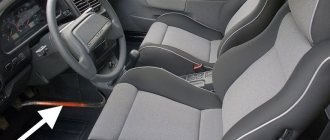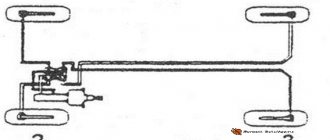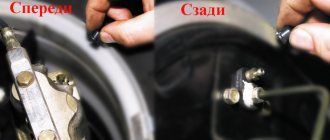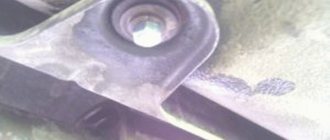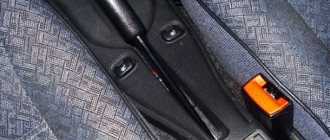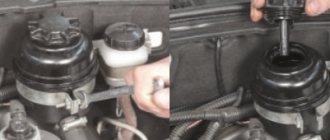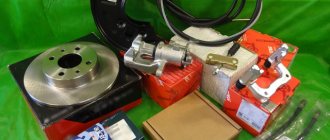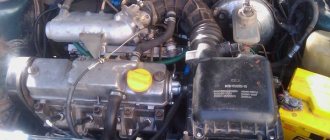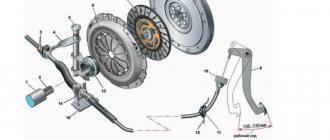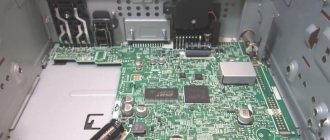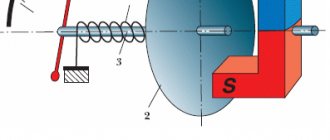How to unscrew the brake bleeder fitting?
Very often, the brake bleeder fitting on the wheel brake cylinder (both front and rear) can “sour” and cannot be unscrewed. Using the example of the bleeding fitting of the front brake mechanism (caliper) of a VAZ 2109 (2108, 21099) car, we will tell you how to independently overcome this problem, which does not allow you to properly bleed the hydraulic drive of the brake system.
Tools for unscrewing the fitting
A special wrench for bleeding brakes (a good, not “licked” special wrench with a crimp head is the first condition for the successful completion of this work)
A special wrench for unscrewing the fittings in the brake system of a car
Hammer (small)
Wire brush
Penetrating liquid
Preparatory work
We fix the car on a level surface
Jack up and remove one of the front wheels of the car
We clean the caliper (brake mechanism) from dirt.
We use a metal brush. Pay special attention to the brake bleeder fitting. We thoroughly clean it and treat it with a penetrating liquid. Thorough cleaning is the second main condition for the successful completion of this work.
How to unscrew the brake bleeder fitting?
We loosen the contact between the fitting and the brake cylinder
To do this, lightly tap it from different sides with a small hammer. We try not to damage the fitting and cylinder. This is the third main condition for successfully unscrewing the fitting.
Tap (lightly) the bleeder fitting with a large hammer
Unscrew the fitting using a special key
We use a spanner wrench (with a crimp head) to bleed brakes with a diameter of 8 mm. We put the key on the fitting and tighten the fixing bolt to ensure a tight fit. We unscrew the fitting. When unscrewing, periodically twist it back and forth.
Unscrew the fitting using a special key
After loosening the fitting, brake fluid should flow out of it. If this does not happen, we try to clean its outlet hole with a needle or awl.
In this simple way (subject to the three conditions described above), you can unscrew a “soured” fitting in most cases. If this fails, the fitting will either have to be drilled out or the wheel brake cylinder replaced with a new one or a known good one. Sometimes replacing a cylinder is advisable because its piston has been jammed for a long time and cannot be developed.
Notes and additions
If you or someone before you has already tried to unscrew the bleeder fitting and “licked” its edges, you can slightly restore them with a file so that there is something to grab onto with a special key.
If the fitting is broken, you can try to drill it out with a drill of a slightly smaller diameter. Then remove the debris and screw in a new fitting.
To prevent the fitting from “souring,” it is necessary to put a protective rubber ring and a protective cap on it. As a result, in any conditions, the fitting will be unscrewed with a regular 8 mm spanner or a special socket wrench (see the image at the beginning of the article).
TWOKARBURATORS VK -More information on the topic in our VKontakte group
How to Bleed Brakes If the Fitting Won't Unscrew
How to bleed a brake with broken fittings
Many car owners are faced with the problem of bleeding brakes. In this article I will explain how to bleed a brake with a damaged fitting.
To bleed the brakes you will need: a container (preferably transparent), a rubber or plastic hose (preferably transparent) and brake fluid. Also, we need another reasonable person to step on the brake pedal and make sure all the fluid doesn't leak out of the master cylinder.
Usually, to bleed the brakes, you need to pour some water into a jar. Next, install the hose or pipe onto the pump filter located on the brake cylinder or caliper. Place the other end of the hose or tube into a container of brake fluid. One person presses the brake pedal repeatedly. When the brake pedal begins to apply pressure, the person presses the pedal and holds it down. Another person opens the device by swinging it, slightly unscrewing it with a wrench. There are air bubbles in the jar. When the pedal is pressed, the fitting closes and the function repeats. After several such cycles, no air is observed in the can, and the brake pedal begins to press hard (so as not to fail).
How to unscrew a “licked” pump fitting
They often break down by licking the front of the brake lines and clutch cylinders.
Emergency method of bleeding from the brake system
Emergency method of bleeding the brakes
system.
The video shows another method to disable the brakes
.
But not long ago I ran into a problem. When she tried to unscrew the valve, it broke. The internet recommends replacing the brake cylinder or caliper. However, as an alternative, you can drill out the old fitting and trim the final threads. And tighten the new fittings. In the first case, a new brake cylinder or caliper must be installed. And if the cylinder is still not so expensive, then it is a caliper. Spare part not available. Drilling fixtures are also dangerous. You don’t always succeed. And in case of trouble, you will be in a depressurized state and will be left without brakes at all. You also need to have spare accessories. Third tip: it is not enough to unscrew the brake pipe and leave the car for several hours so that the fluid can slowly flow out along with the air.
I decided to do it using this method. First I unscrewed the brake pipe. When one person carefully pressed the pedal, I unscrewed the tube. Later I unscrewed it. But ok brake pump this method failed. There was air in the balloon. Then I removed the brake drum. The man in the cabin carefully pressed the pedal. At first it was a hiss. The air is out. Later, brake fluid leaked. Then I tightened the brake pads and installed the drum. The gearing may not have been perfect, but the braking was vastly improved. I traveled this way for several months.
True, there was one drawback. By pressing the brake pedal , the brake fluid broke the boot on the brake cylinder. To prevent this, it may be better to remove or lower the boot before loading.
Main. Press the pedal very slowly so that the pads do not move out and the brake cylinder does not crumble. Be sure to add fluid on time. brake cylinder .
If there is such a problem in the caliper (C), I think you can remove it and carefully press the pedal.
Features of unscrewing a rusted tube
Parts of the brake system (TS), except for “consumables”, last quite a long time, mainly the pads and, if necessary, discs are changed on the car. Connections of brake pipes (TT), cylinders, hoses “sour” over time for a number of reasons:
- Dirt, salt, and moisture enter the parts located at the bottom of the car from the road;
- the temperature difference influences - when the pads interact with the drums/discs, heating occurs, when water or snow “porridge” gets in, a sharp cooling occurs;
- nuts, fittings, bolts are not loosened for a long time, a kind of sticking occurs.
Emergency method of bleeding the brake system
If for some reason your fitting turns out to be broken or licked, use the emergency bleeding method. You can simply bleed the brakes using a brake hose.
- Raise the car on a lift or securely fix it on the ground.
- Remove the wheel.
- Take a spanner and run the brake hose. Then tighten it.
ATTENTION! At this point, some brake fluid will leak out.
- Signal your partner to start pumping the brakes.
- After pressing a few times, run the brake hose again and drain some brake fluid.
Repeat the procedure 5-10 times until the brake pedal becomes hard again. You can bleed the brakes this way at any time.
Removing the brake wheel cylinder
On cars with drum brakes, working cylinders are installed on the rear axle; the problem is that their mounting bolts boil and break off in the housing. When the cylinder is being replaced, there is no problem, but in some cases the part needs to be preserved, and after removal it must be put back in place.
In order not to break off the fasteners (usually the cylinder is held on by two bolts), before unscrewing, you should also tap with a hammer through a drift; you can knock on the bolts themselves (being careful not to spoil or flatten the edges), next to the fasteners on the cylinder body. And here we don’t forget to use WD-40, this usual method helps without fail. You should unscrew the bolts with a socket wrench, do not force the bolts off and, again, do not rush.
As you know, the main reason for sticking of any element in a car is operation at elevated temperatures. If it is obvious that there is a high temperature in the internal combustion engine during operation, then drivers may wonder what is causing the brake pipe to become soggy. It's very simple, when the car brakes, the calipers and drums absorb energy, accordingly, heat is released, and the components of the braking system become very hot. When water gets on these components, for example, when running over a puddle, they cool sharply, which is why sticking occurs.
Volvo brake bleeder valve broken
- MegaSergei
- 03.11.2015
- 1084
Hello, dear Volvo lovers.
Today we will touch upon such a nuisance as a broken fitting when trying to bleed the brake. Everything happens according to the usual scenario. It is necessary to bleed the fluid in the system, but the caliper fitting does not budge. We try to knock - nothing, we try this way and that - in the end we break it.
I ran into the same problem today after replacing a brake pipe. I squeezed as much air out of the cylinder through the hose connection as I could. I sat and thought, went and bought a set of extractors in case of drilling, prepared taps just in case. But in the process of removing the caliper, I decided to use the most powerful method - welding... But first things first:
So, we take off the wheel and observe the break; in my case, it protruded slightly above the surface of the caliper:
Let's start removing the caliper, because in a vice you can do such work much better and more calmly. We remove the brake caliper spring, unscrew the two guides with a 45 Torx bit from the back, after first removing the plugs.
We unscrew the brake hose, after we remove it, we turn it counterclockwise with the caliper itself, since the hose does not rotate around its axis.
Caliper on the workbench, inspection and selection of nuts; in my case, the ten fit like original. A small piece of fitting protruding above the caliper gave me the opportunity to weld to the nut. The process took a lot of time, I ruined five or six nuts, but the last time, almost waving my hand, the breaker clicked and unscrewed by hand.
Then, with a breaker and a caliper for fitting, wrapped in a rag, run to the VAZ spare parts store. Oddly enough, they immediately gave me what I needed. I don’t know from which model of the domestic automobile industry, but the asking price is exactly 50 rubles (Volvov’s costs 400 rubles to order - 2 days).
I advise anyone who is faced with such a problem not to rush. Take three deep breaths and move forward little by little.
Brake bleeder fitting: how to unscrew?
Brake bleeder fitting: how to unscrew?
by Fedor » Oct 04, 2010 10:13 am
The process of pumping the brake circuit of the front left wheel stopped because I could not unscrew the fitting through which the brake fluid is drained. Apparently, he got used to it.
I tore off the edges of the fitting, it’s not difficult
Share your experience and thoughts on what to do next.
Question for materials scientists: what is the caliper made of?
The fitting is the protrusion under the longest bolt in the picture
- Reply with a quote
Re: Brake bleeder fitting: how to unscrew?
shyrik974 » Oct 04, 2010 10:19 am
- Reply with a quote
Re: Brake bleeder fitting: how to unscrew?
by Fedor » Oct 04, 2010 10:23 am
- Reply with a quote
Re: Brake bleeder fitting: how to unscrew?
shyrik974 » Oct 04, 2010 10:26 am
- Reply with a quote
Re: Brake bleeder fitting: how to unscrew?
Bang » 04 Oct 2010, 10:28
- Reply with a quote
Re: Brake bleeder fitting: how to unscrew?
by Fedor » Oct 04, 2010 10:31 am
- Reply with a quote
Re: Brake bleeder fitting: how to unscrew?
shyrik974 » Oct 04, 2010 10:33 am
- Reply with a quote
Re: Brake bleeder fitting: how to unscrew?
Bang » 04 Oct 2010, 10:37
- Reply with a quote
Re: Brake bleeder fitting: how to unscrew?
DJEM » 04 Oct 2010, 10:40
- Reply with a quote
Re: Brake bleeder fitting: how to unscrew?
by Fedor » 04 Oct 2010, 11:03
- Reply with a quote
Re: Brake bleeder fitting: how to unscrew?
Ferapont » 04 Oct 2010, 11:07
- Reply with a quote
Re: Brake bleeder fitting: how to unscrew?
Bang » 04 Oct 2010, 11:08
There is an option to drill a hole in the fitting using a three-piece for bleeding and then a bolt there.
Added after 1 minute 13 seconds:
- Reply with a quote
Re: Brake bleeder fitting: how to unscrew?
shyrik974 » Oct 04, 2010 11:13 am
- Reply with a quote
Re: Brake bleeder fitting: how to unscrew?
Pat » 04 Oct 2010, 11:16
- Reply with a quote
Re: Brake bleeder fitting: how to unscrew?
Bang » 04 Oct 2010, 11:33
shyrik974 , And in your opinion, “drilling” means using a ten where there was an eight? Then of course it's a shame.
To drill correctly is if, say, there was a ten, drill with a six, if it went normally in the center, then with an eight. There is a huge chance that the bolt will move during the process - then we unscrew it. If not, then we hammer a hexagon or an asterisk into the drilled hole, or I forgot what the cone is called, there is one specifically for these purposes and we tear it off with it. Even if the sprocket starts to scroll, eventually the hole is developed to the point where only the thread remains in the thread itself - and then it comes out with a bang. If not, then use an awl to clear the entry into the thread so that the tap goes along the thread and, with oil, we go through the thread with a tap. The fact that this thread of the thread will become stuck to such a state that it can no longer be removed even if you go through the thread with a tap - I have never seen this. If done carefully, the likelihood of stripping the thread is extremely low. Only if your hands are extremely crooked, there is no habit of turning your head on in time and there is zero experience.
- Reply with a quote
The brake bleeder fitting is broken, what should I do?
The brake system is one of the key components of the correct and safe operation of a car. Any malfunction in the brakes can result in a problem or tragedy for all road users. To avoid problems while driving, it is necessary to constantly monitor the condition of all parts of the system: discs and pads, and especially the brake fluid.Brake bleeding is required in the following cases:
You noticed that the brake pedal has become “softer” and its travel has increased. You have repaired or serviced the brake discs, replaced the brake pads, or completely tuned the brake system.
In these cases, it is definitely necessary to bleed the brake system to remove air. Procedure for bleeding the brakes
As always, you have a choice of how to level up. You can contact a car service. There you will be bled using a brake bleeder. A modern and efficient unit designed to remove air from the brake system. The professional brake bleeding device is equipped with adapters that allow it to work with many existing models of cars and trucks.
The second option is to bleed the brakes yourself. In principle, the procedure for bleeding the brakes is the same for any system. You will need a simple homemade device for bleeding the brakes from a syringe, tubes (hoses) and a plastic container. Options for pumping yourself: two people or one person, i.e. you yourself.
Scheme for bleeding the brakes: you should start from the wheel that is located at a far distance from the GTZ.
- rear right wheel mechanism;
- front left wheel mechanism;
- rear left wheel mechanism;
- front right wheel mechanism.
Bleeding the brakes with a partner
Remove the plug that covers the brake bleeder fitting and put a transparent hose on it. We lower the free end of the hose into a container partially filled with brake fluid.
The partner presses the brake pedal with intensity 3-4 times and leaves it pressed. You slightly unscrew the bleeder nipple until the brake fluid begins to be forced into the container. You can determine the presence of escaping air by the bubbles in the liquid in the container.
